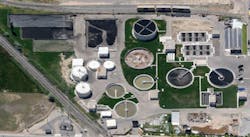Separated Out
In 2000, the Spanish Fork (Utah) Wastewater Treatment Plant (WWTP) was looking for screening technology that would upgrade its present bar screen and rake system. Too many contaminants were making their way into the channel flow and causing problems with manpower consumption, end-product quality and EPA limits.
Challenge
The contaminants that the bar screen allowed into Spanish Fork’s process wreaked havoc in several ways. They drove down the quality of end products, drove up the cost of processing and jeopardized EPA approvals. While contaminant levels from chemicals are very important to passing EPA compliance standards, solid contaminants, such as plastics, also jeopardize EPA compliance and can culminate in additional processing and fines that can reach $10,000 per day. Removing solids early in the process eliminates the risks that their presence can create down the line and ensures efficient processing and high-quality end products.
Solution
The plant chose the STEP SCREEN from Huber Technology because it looked simple. It has few moving parts and a very straightforward concept for taking contaminants out of the flow at the head works—before it starts its downstream process.
Spanish Fork utilizes the STEP SCREEN in two identical head works systems. The technology upgrade has made a vast difference in plant processing. Prior to the implementation of new technology, only one channel was processed. The efficiencies of the STEP SCREEN technology allowed Spanish Fork to double flow processing and make the plant more productive. In addition, the facility’s flow is cleaner. Plastics do not get to the digester because they are removed before they reach the channel. The removal of solids—such as plastics, rags and hair—is critical in improving efficiency and quality because fewer solids take up less space in the digesters and create more room for biosolids. The sludge that collects in the bottom of the clarifiers is of higher quality, meets EPA standards and can be used as fertilizer.
Spanish Fork depends on the STEP SCREEN to improve wastewater screenings capture beyond what bar screening technology can provide, elevate its confidence in the end products it produces and increase throughput in the plant without increasing manpower.
Results
“My mother-in-law wanted fertilizer for the flower barrels she plants each spring,” said Plant Superintendent Dennis Sorensen. “I told her that I could give her something to use, but she might find some undesirable elements that she would need to separate out before doing her plantings. I gave her the fertilizer and she did end up separating quite a collection of what our guys call ‘party favors’ from the sludge. After we put the STEPSCREEN technology in place, the mother-in-law inquired about what had happened to our fertilizer because it was completely clear of all undesirables. Her undesirable collection simply didn't exist.”
The fact that Spanish Fork collects that quality level of sludge from clarifiers without re-straining it is proof that the STEP SCREEN does its job efficiently.
Sorensen admits that initially his STEP SCREEN needed some tweaking. There was an issue with a push rod that had the support team mystified. Instead of scratching their heads, the Huber team called in their key service expert on the technology. After examination, push rod replacement and a few tweaks, the STEP SCREEN worked without incident, and has ever since that occurred in 2000.
The STEP SCREEN rarely requires attention. And when it does, the culprits are typical wear-and-tear items such as bearings and gearboxes. Huber’s team is quick to respond, regardless of what the need is, and have processes up and running within a day or so.
Response to parts replacement is fast: perhaps a day for delivery from stateside supply and only three days or so when delivering from Germany.
STEP SCREEN’s design and manufacturing quality provides clients with reliable performance. Hard-working technology does require parts replacement and maintenance, and when that is required, clients find the same reliability in Huber’s support and services that they discover in its technology.
